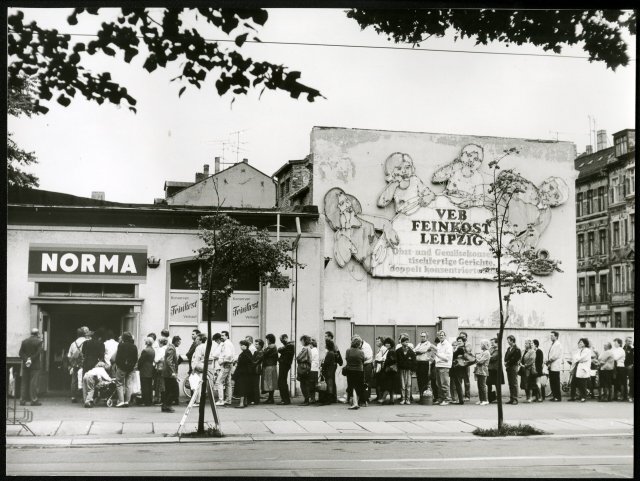When Norma was still awesome: The old feeling of queuing in front of a new shop on Karl Liebknecht Street shortly after the so-called reunification
Photo: Siegfried G. Mueller
Whether they were crazy to create an exhibition about a time that almost everyone lived through – and also a decade like the 90s, about which many people had an emotionally charged opinion. According to the exhibition team “Between departure and settlement,” they were confronted with such questions at the beginning of the project. The 90s in Leipzig«. The exhibition shows a post-reunification period that for many people meant a biographical break, the loss of work, the loss of the country in which they lived or a lost battle for a better socialism, but also new opportunities in a liberal, capitalist society.
»The time of reunification carried things forward from the GDR, but they became more and more invisible over time. The structures of the Federal Republic, the administration, the politics dominated everything,” said the curator of the exhibition, Johanna Singer, to “nd”. “We want to ask the question: What made the East or a city like Leipzig so special?” The exhibition team has collected hundreds of objects from everyday life, from demonstration banners from the Monday demonstrations and the environmental movement of the post-reunification period to posters and wall newspapers from associations such as the queer association RosaLinde, which is still an important educational and advisory institution in Leipzig today. The boxing coat and gloves of Henry Maske, the famous boxer from Brandenburg and former Olympic champion, are on display, as well as football posters, because the 90s were the time when VfB Leipzig was re-founded, which later merged with 1. FC Lokomotiv. Documents from the Treuhand period, a consumer sign and interviews from a contemporary witness project that was carried out for the exhibition are packed into a small space in the Leipzig City History Museum.
In total, the team selected around 400 objects from more than 30 collections and archives. In keeping with the renovation character, the objects are displayed on scaffolding. There are few explanations about the objects. The socio-political framework conditions, such as the change in projects such as the AG Homosexuality from the GDR to the post-reunification period, sports funding, political repression, money flows and the respective economic circumstances are only examined superficially. The exhibition also does not go into the political depth of the movements that did not want to give up socialism after the fall of communism. The focus is on everyday life, shopping and working. »The older generation may want to remember or find things in which they see themselves confirmed. Young people, on the other hand, may not know anything about this time, so we want to interest them in the topic,” says Johanna Singer. In this way, the exhibition presents well-known readings of the circumstances and, above all, offers space for personal perception, interpretation and self-assurance.
Before the opening, the exhibition team conducted and evaluated interviews with ten contemporary witnesses. However, the singers and their employees do not consider the exhibition to be finished: Even now, new objects can be displayed in a “changing display case” in consultation with the team so that as many stories as possible are represented. Depicting everyday life over a decade in a city with all its ambivalences, instead of just picking out individual aspects, is a challenge.
»Society and discourse are very heated right now. This is also because black and white thinking prevails and people don’t talk about the shades of gray. “We can meet exactly in the shades of gray,” says Annemarie Riemer, who is responsible for education and communication in the exhibition. The museum wants to offer this space. Johanna Singer also believes that portraying history through more than just government decisions and institutions is becoming increasingly relevant: “It is important that non-political people are also included and taken seriously.” Riemer adds: “I hope that with this exhibition we will achieve a change of perspective. That people notice that other people experienced this time differently than they did and that this doesn’t have to be what separates us. My job is also to ask the right questions. This has great potential, especially with this topic.«
The exhibition is accompanied by panel discussions about (post-)migrant life in the years after reunification, about the free cultural scene, the right-wing and apolitical violence of the so-called “baseball bat years” and the role of politics and administration as well as film screenings.
»Between departure and settlement. The 90s in Leipzig”, until September 7, 2025, Leipzig City History Museum
Subscribe to the “nd”
Being left is complicated.
We keep track!
With our digital promotional subscription you can read all issues of »nd« digitally (nd.App or nd.Epaper) for little money at home or on the go.
Subscribe now!
